Engaging Senior Executives in Care of Mechanically Ventilated Patients: Slide Presentation
AHRQ Safety Program for Mechanically Ventilated Patients
Slide 1: AHRQ Safety Program for Mechanically Ventilated Patients
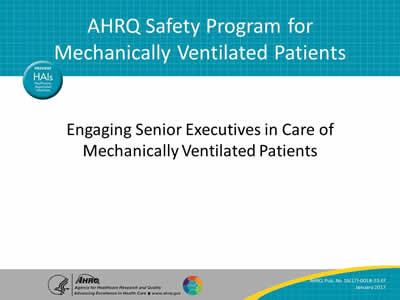
Engaging Senior Executives in Care of Mechanically Ventilated Patients
Slide 2: Learning Objectives
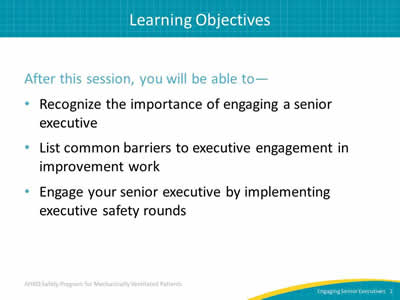
After this session, you will be able to—
- Recognize the importance of engaging a senior executive.
- List common barriers to executive engagement in improvement work.
- Engage your senior executive by implementing executive safety rounds.
Slide 3: To Err Is Human
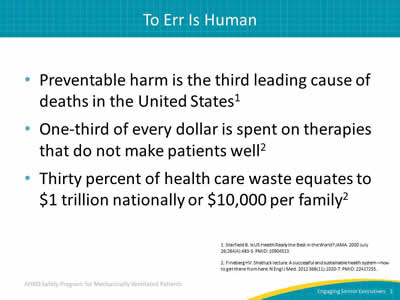
- Preventable harm is the third leading cause of deaths in the United States.1
- One-third of every dollar is spent on therapies that do not make patients well.2
- Thirty percent of health care waste equates to $1 trillion nationally or $10,000 per family.2
1. Starfield B. Is US Health Really the Best in the World? JAMA 2000 July 26;284(4):483-5. PMID: 10904513.
2. Fineberg HV. Shattuck lecture. A successful and sustainable health system—how to get there from here. N Engl J Med 2012 Mar 15;366(11):1020‐7. PMID: 22417255.
Slide 4: Comprehensive Unit-based Safety Program (CUSP)
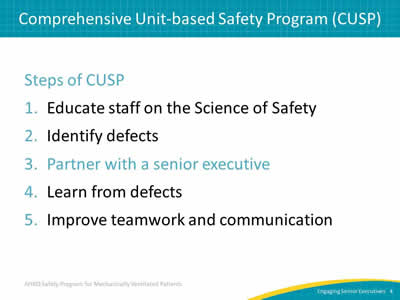
Steps of CUSP:
- Educate staff on the Science of Safety.
- Identify defects.
- Partner with a senior executive.
- Learn from defects.
- Improve teamwork and communication.
Slide 5: Why Do We Need an Executive?
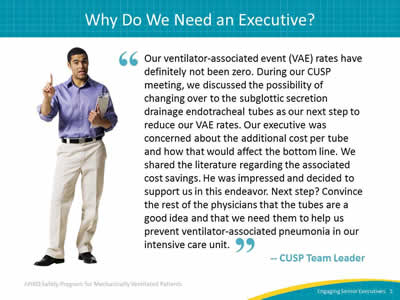
"Our ventilator-associated event (VAE) rates have definitely not been zero. During our CUSP meeting, we discussed the possibility of changing over to the subglottic secretion drainage endotracheal tubes as our next step to reduce our VAE rates. Our executive was concerned about the additional cost per tube and how that would affect the bottom line. We shared the literature regarding the associated cost savings. He was impressed and decided to support us in this endeavor. Next step? Convince the rest of the physicians that the tubes are a good idea and that we need them to help us prevent ventilator-associated pneumonia in our intensive care unit."
—CUSP Team Leader
Image: Man in casual business attire holding clipboard in left arm and raising index finger of right hand.
Slide 6: Executive Partnership—Win-Win
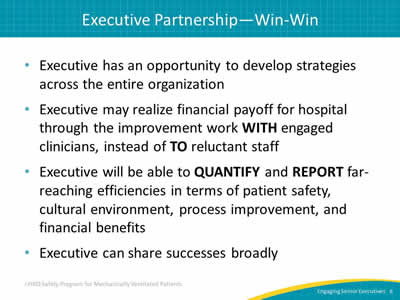
- Executive has an opportunity to develop strategies across the entire organization.
- Executive may realize financial payoff for hospital through the improvement work WITH engaged clinicians, instead of TO reluctant staff.
- Executive will be able to QUANTIFY and REPORT far-reaching efficiencies in terms of patient safety, cultural environment, process improvement, and financial benefits.
- Executive can share successes broadly.
Slide 7: What Does an Executive Offer?
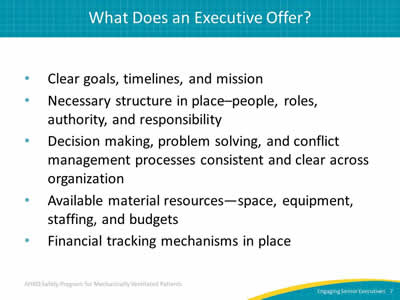
- Clear goals, timelines, and mission.
- Necessary structure in place–people, roles, authority, and responsibility.
- Decision making, problem solving, and conflict management processes consistent and clear across organization.
- Available material resources—space, equipment, staffing, and budgets.
- Financial tracking mechanisms in place.
Slide 8: Barriers to Executive Engagement
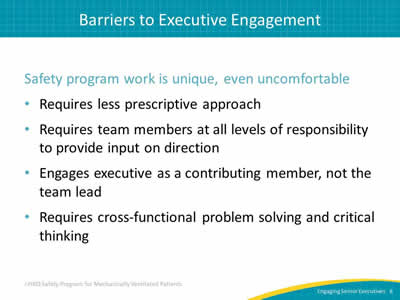
Safety program work is unique, even uncomfortable:
- Requires less prescriptive approach.
- Requires team members at all levels of responsibility to provide input on direction.
- Engages executive as a contributing member, not the team lead.
- Requires cross-functional problem solving and critical thinking.
Slide 9: Addressing Executive Concerns
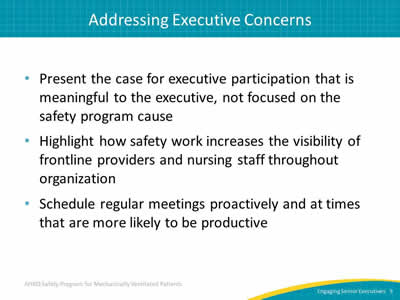
- Present the case for executive participation that is meaningful to the executive, not focused on the safety program cause.
- Highlight how safety work increases the visibility of frontline providers and nursing staff throughout organization.
- Schedule regular meetings proactively and at times that are more likely to be productive.
Slide 10: Engaging Your Executive
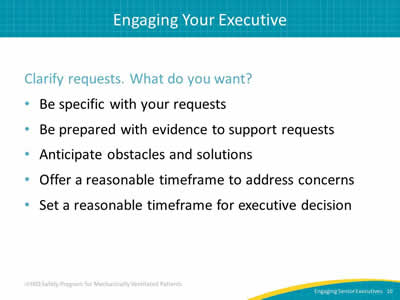
Clarify requests. What do you want?
- Be specific with your requests.
- Be prepared with evidence to support requests.
- Anticipate obstacles and solutions.
- Offer a reasonable timeframe to address concerns.
- Set a reasonable timeframe for executive decision.
Slide 11: Executive Safety Rounds Kickoff
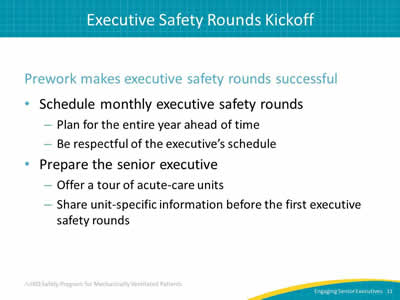
Prework makes executive safety rounds successful:
- Schedule monthly executive safety rounds:
- Plan for the entire year ahead of time.
- Be respectful of the executive’s schedule.
- Prepare the senior executive:
- Offer a tour of acute-care units.
- Share unit-specific information before the first executive safety rounds.
Slide 12: Executive Safety Rounds Kickoff
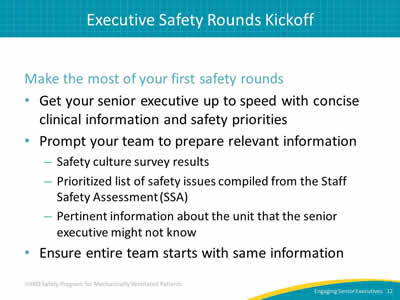
Make the most of your first safety rounds:
- Get your senior executive up to speed with concise clinical information and safety priorities.
- Prompt your team to prepare relevant information:
- Safety culture survey results.
- Prioritized list of safety issues compiled from the Staff Safety Assessment (SSA).
- Pertinent information about the unit that the senior executive might not know.
- Ensure entire team starts with same information.
Slide 13: Executive Safety Rounds Kickoff
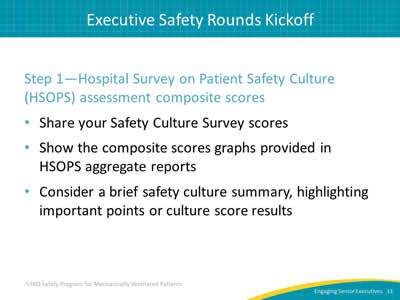
Step 1—Hospital Survey on Patient Safety Culture (HSOPS) assessment composite scores:
- Share your Safety Culture Survey scores.
- Show the composite scores graphs provided in HSOPS aggregate reports.
- Consider a brief safety culture summary, highlighting important points or culture score results.
Slide 14: Executive Safety Rounds Kickoff
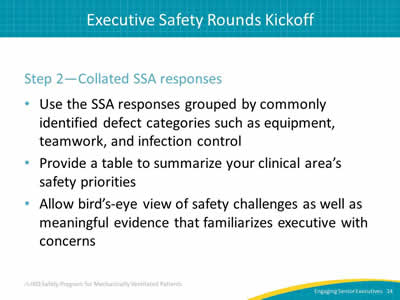
Step 2—Collated SSA responses:
- Use the SSA responses grouped by commonly identified defect categories such as equipment, teamwork, and infection control.
- Provide a table to summarize your clinical area’s safety priorities.
- Allow bird’s-eye view of safety challenges as well as meaningful evidence that familiarizes executive with concerns.
Slide 15: Executive Safety Rounds Kickoff
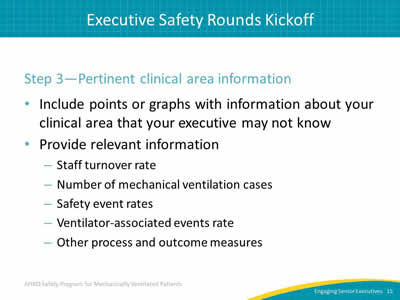
Step 3—Pertinent clinical area information:
- Include points or graphs with information about your clinical area that your executive may not know.
- Provide relevant information:
- Staff turnover rate.
- Number of mechanical ventilation cases.
- Safety event rates.
- Ventilator-associated events rate.
- Other process and outcome measures.
Slide 16: Executive Safety Rounds Kickoff
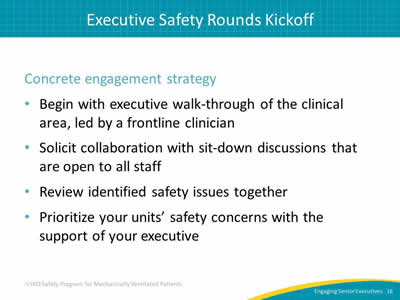
Concrete engagement strategy:
- Begin with executive walk-through of the clinical area, led by a frontline clinician.
- Solicit collaboration with sit-down discussions that are open to all staff.
- Review identified safety issues together.
- Prioritize your units’ safety concerns with the support of your executive.
Slide 17: Executive Safety Rounds Kickoff
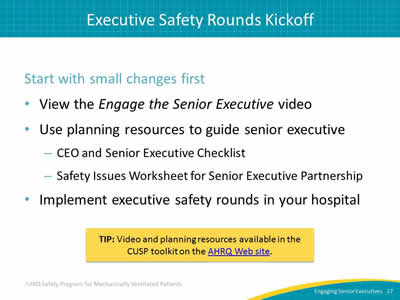
Start with small changes first:
- View the Engage the Senior Executive video.
- Use planning resources to guide senior executive:
- CEO and Senior Executive Checklist.
- Safety Issues Worksheet for Senior Executive Partnership.
- Implement executive safety rounds in your hospital.
Tip: Video and planning resources available in the CUSP toolkit on the AHRQ Web site.
Slide 18: Questions
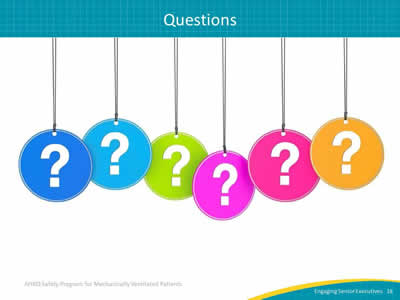
Image: Picture of hanging colored tags with question marks on them.
Slide 19: References
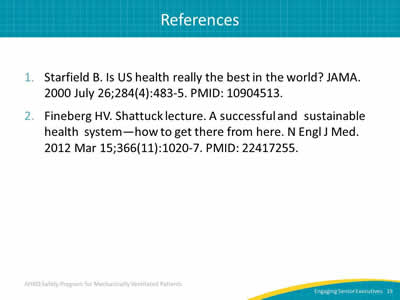
1. Starfield B. Is US Health Really the Best in the World? JAMA 2000 July 26;284(4):483-5. PMID: 10904513.
2. Fineberg HV. Shattuck lecture. A successful and sustainable health system—how to get there from here. N Engl J Med 2012 Mar 15;366(11):1020‐7. PMID: 22417255.



